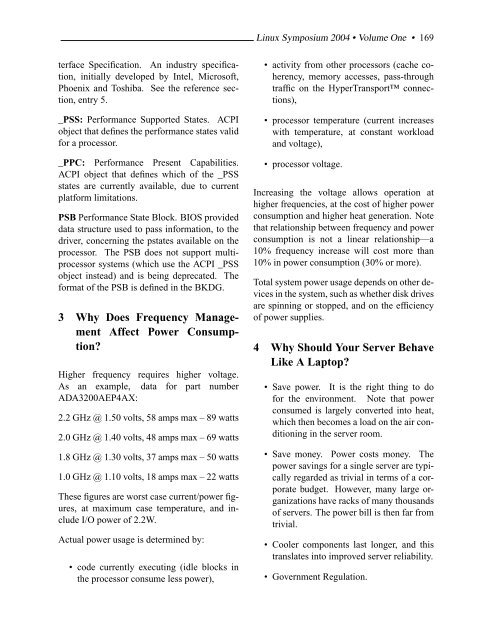You also want an ePaper? Increase the reach of your titles
YUMPU automatically turns print PDFs into web optimized ePapers that Google loves.
<strong>Linux</strong> Symposium 2004 • Volume <strong>One</strong> • 169<br />
terface Specification. An industry specification,<br />
initially developed by Intel, Microsoft,<br />
Phoenix and Toshiba. See the reference section,<br />
entry 5.<br />
_PSS: Performance Supported States. ACPI<br />
object that defines the performance states valid<br />
for a processor.<br />
_PPC: Performance Present Capabilities.<br />
ACPI object that defines which of the _PSS<br />
states are currently available, due to current<br />
platform limitations.<br />
PSB Performance State Block. BIOS provided<br />
data structure used to pass information, to the<br />
driver, concerning the pstates available on the<br />
processor. <strong>The</strong> PSB does not support multiprocessor<br />
systems (which use the ACPI _PSS<br />
object instead) and is being deprecated. <strong>The</strong><br />
format of the PSB is defined in the BKDG.<br />
3 Why Does Frequency Management<br />
Affect Power Consumption?<br />
Higher frequency requires higher voltage.<br />
As an example, data for part number<br />
ADA3200AEP4AX:<br />
2.2 GHz @ 1.50 volts, 58 amps max – 89 watts<br />
2.0 GHz @ 1.40 volts, 48 amps max – 69 watts<br />
1.8 GHz @ 1.30 volts, 37 amps max – 50 watts<br />
1.0 GHz @ 1.10 volts, 18 amps max – 22 watts<br />
<strong>The</strong>se figures are worst case current/power figures,<br />
at maximum case temperature, and include<br />
I/O power of 2.2W.<br />
Actual power usage is determined by:<br />
• code currently executing (idle blocks in<br />
the processor consume less power),<br />
• activity from other processors (cache coherency,<br />
memory accesses, pass-through<br />
traffic on the HyperTransport connections),<br />
• processor temperature (current increases<br />
with temperature, at constant workload<br />
and voltage),<br />
• processor voltage.<br />
Increasing the voltage allows operation at<br />
higher frequencies, at the cost of higher power<br />
consumption and higher heat generation. Note<br />
that relationship between frequency and power<br />
consumption is not a linear relationship—a<br />
10% frequency increase will cost more than<br />
10% in power consumption (30% or more).<br />
Total system power usage depends on other devices<br />
in the system, such as whether disk drives<br />
are spinning or stopped, and on the efficiency<br />
of power supplies.<br />
4 Why Should Your Server Behave<br />
Like A Laptop?<br />
• Save power. It is the right thing to do<br />
for the environment. Note that power<br />
consumed is largely converted into heat,<br />
which then becomes a load on the air conditioning<br />
in the server room.<br />
• Save money. Power costs money. <strong>The</strong><br />
power savings for a single server are typically<br />
regarded as trivial in terms of a corporate<br />
budget. However, many large organizations<br />
have racks of many thousands<br />
of servers. <strong>The</strong> power bill is then far from<br />
trivial.<br />
• Cooler components last longer, and this<br />
translates into improved server reliability.<br />
• Government Regulation.

















